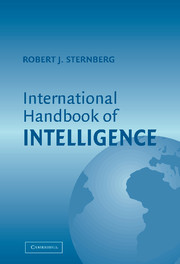Book contents
- Frontmatter
- Contents
- List of Contributors
- Preface
- 1 Intelligence Research and Assessment in the United Kingdom
- 2 Intelligence – Theory, Research, and Testing in the Nordic Countries
- 3 The Psychology of Human Intelligence in Spain
- 4 Psychology of Human Intelligence in France and French-Speaking Switzerland
- 5 Research on Intelligence in German-Speaking Countries
- 6 Is It Possible to Study Intelligence Without Using the Concept of Intelligence? An Example from Soviet/Russian Psychology
- 7 Intelligence Theory, Assessment, and Research: The Israeli Experience
- 8 Intelligence and Intelligence Testing in Turkey
- 9 Intelligence: What Is Indigenous to India and What Is Shared?
- 10 Japanese Conception of and Research on Human Intelligence
- 11 Diligence Makes People Smart: Chinese Perspectives of Intelligence
- 12 Similar Thoughts under Different Stars: Conceptions of Intelligence in Australia
- 13 Being Intelligent with Zimbabweans: A Historical and Contemporary View
- 14 Intelligence Research in Latin America
- 15 North American Approaches to Intelligence
- 16 Human Intelligence: From Local Models to Universal Theory
- Index
- References
2 - Intelligence – Theory, Research, and Testing in the Nordic Countries
Published online by Cambridge University Press: 05 June 2012
- Frontmatter
- Contents
- List of Contributors
- Preface
- 1 Intelligence Research and Assessment in the United Kingdom
- 2 Intelligence – Theory, Research, and Testing in the Nordic Countries
- 3 The Psychology of Human Intelligence in Spain
- 4 Psychology of Human Intelligence in France and French-Speaking Switzerland
- 5 Research on Intelligence in German-Speaking Countries
- 6 Is It Possible to Study Intelligence Without Using the Concept of Intelligence? An Example from Soviet/Russian Psychology
- 7 Intelligence Theory, Assessment, and Research: The Israeli Experience
- 8 Intelligence and Intelligence Testing in Turkey
- 9 Intelligence: What Is Indigenous to India and What Is Shared?
- 10 Japanese Conception of and Research on Human Intelligence
- 11 Diligence Makes People Smart: Chinese Perspectives of Intelligence
- 12 Similar Thoughts under Different Stars: Conceptions of Intelligence in Australia
- 13 Being Intelligent with Zimbabweans: A Historical and Contemporary View
- 14 Intelligence Research in Latin America
- 15 North American Approaches to Intelligence
- 16 Human Intelligence: From Local Models to Universal Theory
- Index
- References
Summary
INTRODUCTION
This chapter describes research on intelligence and practices of assessment in the Nordic countries. For the purposes of this chapter, the Nordic group of countries is taken to comprise Denmark, Finland, Norway and Sweden. These four small (between 4 and 9 million persons) countries, share many characteristics. Three of the countries (Denmark, Norway, and Sweden) have highly similar languages, which are typically understood across countries. The fourth country (Finland) has a Swedish-speaking minority, while the main language (Finnish) is a quite different language than the other languages. All countries also have a high standard of living and are what is often referred to as “welfare states,” with societal solutions to problems such as medicine, health care, unemployment, and education. From a cultural point of view, there are also are many similarities among the four countries, which go far back in history.
DEFINITIONS AND MEASUREMENT OF INTELLIGENCE IN THE NORDIC COUNTRIES
Conceptions of intelligence in the Nordic countries have been very strongly influenced by the psychometric research traditions that were developed in Britain, the United States, and elsewhere. There has, thus, been a strong focus on development and adaptation of tools for measuring intelligence and on empirical approaches in research on intelligence.
DEVELOPMENT OF TESTING
As was observed by Carroll (1982), the fundamental principles of the technology of intelligence testing were well established by the 1930s, whereas the development after this time may be described as elaborations, extensions, and refinements of these basic principles.
- Type
- Chapter
- Information
- International Handbook of Intelligence , pp. 49 - 78Publisher: Cambridge University PressPrint publication year: 2004
References
- 2
- Cited by

